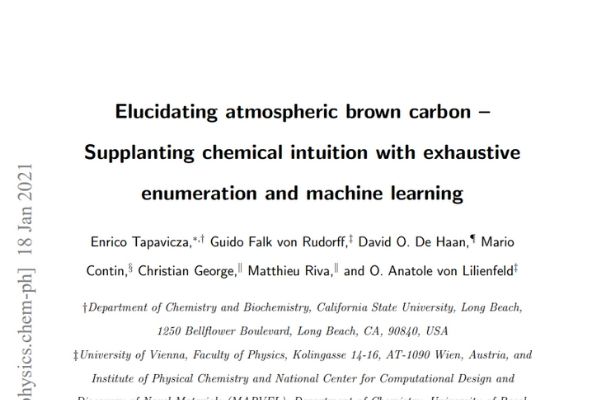
Elucidating atmospheric brown carbon -- Supplanting chemical intuition with exhaustive enumeration and machine learning
Chemical Physics (2021) https://arxiv.org/abs/2101.07301
Authors: Enrico Tapavicza, Guido Falk von Rudorff, David O. De Haan, Mario Contin, Christian George, Matthieu Riva, O. Anatole von Lilienfeld
To unravel the structures of C12H12O7 isomers, identified as light-absorbing photooxidation products of syringol in atmospheric chamber experiments, we apply a graph-based molecule generator and machine learning workflow. To accomplish this in a bias-free manner, molecular graphs of the entire chemical subspace of C12H12O7 were generated, assuming that the isomers contain two C6-rings; this led to 260 million molecular graphs and 120 million stable structures. Using quantum chemistry excitation energies and oscillator strengths as training data, we predicted these quantities using kernel ridge regression and simulated UV/Vis absorption spectra. Then we determined the probability of the molecules to cause the experimental spectrum within the errors of the different methods. Molecules whose spectra were likely to match the experimental spectrum were clustered according to structural features, resulting in clusters of > 500,000 molecules. While we identified several features that correlate with a high probability to cause the experimental spectrum, no clear composition of necessary features can be given. Thus, the absorption spectrum is not sufficient to uniquely identify one specific isomer structure. If more structural features were known from experimental data, the number of structures could be reduced to a few tens of thousands candidates. We offer a procedure to detect when sufficient fragmentation data has been included to reduce the number of possible molecules. The most efficient strategy to obtain valid candidates is obtained if structural data is applied already at the bias-free molecule generation stage. The systematic enumeration, however, is necessary to avoid mis-identification of molecules, while it guarantees that there are no other molecules that would also fit the spectrum in question.
Subjects: Chemical Physics (physics.chem-ph)
Cite as: arXiv:2101.07301 [physics.chem-ph]
(or arXiv:2101.07301v1 [physics.chem-ph] for this version)



